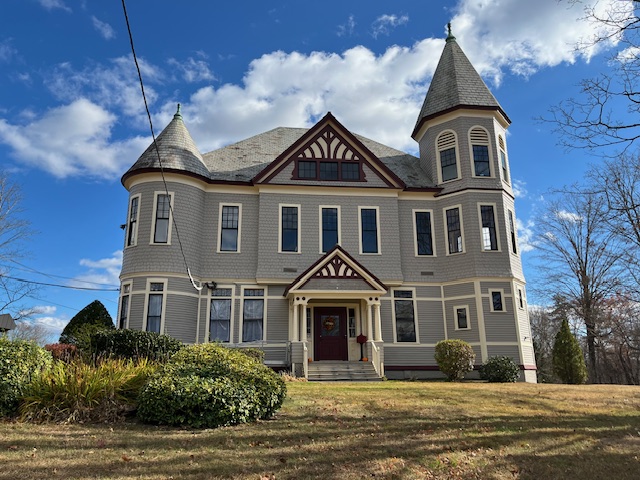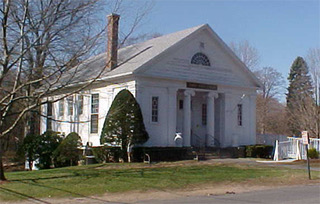Amherst’s Neighboring Towns: Granby

A Granby schoolhouse, from about 1840, Photo: Hetty Startup
Amherst History Month by Month
This column is the sixth in a 10-part series about towns surrounding Amherst. Previous columns covered Pelham, Shutesbury, Sunderland, Hadley and Belchertown. For a listing of all previous “Amherst History Month by Month” columns, look here.
How do you get from Amherst to Granby? You drive over the Notch from the “dog bone” rotary by Atkins. The word notch stands for the “cracks” or gaps that occur between the individual peaks in the chain of the Holyoke range, the result of the cracking of underlying volcanic basalt by geologic faults, followed by erosion of the cracks over time. The Range’s distinctive profile dominates Amherst’s southern skyline. It anchors us to this special place in the world.
Although you have barely left Amherst, you are now just south of the mountain, and have gone past the distinctive stone crusher site of John S. Lane/Trap Rock open-face gravel pit. This historic business, once owned by the Cowls/Cinda Jones family, is always a happy sight if coming though the Notch on a snowy night. You take a left off Route 116 onto Amherst Street heading almost due south. The expression “south of the mountain” (originally an indigenous expression) suggests an orientation attuned to nature.
Although I am not a native of this country, I like to think about phrases like this perhaps because it connects us today with what was here before Granby even existed as a town. I imagine the lay of the land about 14,000 BCE, when glaciers that had been in this area slowly retreated. A newer landscape prevailed, first of tundra with cold, short growing seasons; then later on, more open woodlands of spruce. To envision the landscape from before white settlers (like me) were here, I check out a place about forty miles away, Granby CT, where the recovered skeletal remains of big game-type animals demonstrate support in that area for indigenous peoples living with the now extinct mammoth, mastodon, giant beaver, giant ground sloth, and musk ox as well as caribou and elk. We are, of course, also in the path (in the Connecticut River Valley) of the areas where dinosaur footprints have been found and yet presently, we are only about 15 miles north of Springfield. I try to grapple with this contrast in my mind. Granby has both ancient indigenous lands, as far I can tell, unceded, and a very visible rural colonial past. Today, like its neighbor South Hadley, it is characterized as a “bedroom suburb” filled with many small businesses, suburban housing, wonderful farm stands and beautiful historic homes. The public housing complex is designed in the Colonial Revival style, to look like a series of ancient colonial homes strung together in a semi-circle called Phins Hill Manor, seen from Route 202 heading into the historic center.

Route 202 becomes Granby’s State Street heading east towards Belchertown: the McDuffie School is here, an educational institution that since 2011 has been located in the former St. Hyacinth’s Seminary. Bordering Ludlow to the south, Granby is also known today for several historic dairy farms (Meadowcroft Dairy, and the Cooperative Creamery (Stebbins Clark) as well as a picturesque mill village called Aldrich Mills. Up by Aldrich Mills, in the northern part of the town, is Batchelor Brook, that with Stony Brook, feeds into the Connecticut River in South Hadley. Both bodies of water served indigenous groups as well as farming and factory communities.
Aldrich Mills is one of the first areas of architectural and historic significance that you come to off Route 116. Both Granby and South Hadley were a part of Hadley until 1733. Granby was settled in 1721 “south of the mountain” and had been Hadley’s second precinct (Amherst was established from Hadley’s third precinct.) Granby’s historic, cultural and architectural sites span the millennia: one unique cultural site, Nash’s Dinosaur Land, used to be on the Granby side of the border with South Hadley. Dino Land was a privately-owned dinosaur track quarry that was in business since the World War II era (I’ve seen 1939 and 1945 as founding dates of the cultural site managed by the Gingras family). A three-toed dinosaur footprint is part of the background of the Granby town seal to this day.

On the other end of town, nearer to Belchertown, is the distinctive mid-twentieth century roadside diner called the Earlee Mug, with its faux milk-bottle wing, which was serving up lunch when I pulled in. It is always exciting to find these slightly wacky buildings in New England and they are an important legacy today, having been reclaimed as significant with the advent in architecture of Post-Modernism.
Granby’s topography suggests its treasures that lie off the beaten path of Amherst Street heading south to Granby Center. Rugged, wooded terrain at this time of year allows us to see the lay of the land more clearly. Batchelor Brook – which wiggles and winds through here – was impounded by a stone dam to create Aldrich Lake, and this comes into view in Granby Hollow. The dam itself is accessed off Aldrich Street. A mill here first operated as a distillery. “In 1812, a handful of distilleries used the surplus grain of Granby farms to produce whiskey” but in the 1830s the site was a fulling mill (used to process wool), and during the Civil War, supplied the Union army with wool blankets. According to the Historic American Building Survey report, “The Aldrich Mill is an unusual survival of a two story, mid-19th century, multi-purpose mill with external, overshot waterwheel intact.”

By 1870, nothing remained of the older mill building. According to records in the Massachusetts Cultural Resouce Information System, after a fire, in 1872, the mill complex was rebuilt from the ground up in 1878 by Christopher C, Aldrich. So “…the mill itself, at 50 Aldrich St., is an antiquarian reconstruction that began sometime after the original mill was destroyed by fire,” By 1913, this reconstruction was used as a blacksmith shop. It is all quite hard to imagine today because “The only industrial feature to survive from this period is the one-story wood frame building with a brick basement on the north side of the dam at 49 Aldrich Street that reputedly functioned as an office and store for the Ayres & Aldrich Co., which produced wool “satinet” cloth.” [Massachusetts Cultural Resource Information Sytem] By the 1940s, an Aldrich descendent, Elbert Aldrich added a large overshot water wheel (the largest in New England ever built and apparently purely cosmetic.) By the 1960s tourists began visiting the site, particularly photographers and artists. In addition to the aforementioned dinosaur footprint, the Granby town seal also includes the mill. But around 1986 it was dismantled, and the site was later abandoned.

Granby’s town common is full of historical and architectural significance. In a book about the town, (Old Houses: Granby, Massachusetts, by Esther Gallup Snyder, 1965) a photo showing the common shows it lined with picket fencing.

The building at the highest point is the United Church of Christ, designed by Elias Carter in 1820-1, and across from it is Granby’s original meeting house, which now serves as the Granby Historical Society.
Further east is the Queen Anne style Kellogg Hall (named for Chester Kellogg) designed by architect George B. P. Alderman and constructed by a Belchertown contractor H. D. Hoag in 1889. The Springfield Republican noted that the second-floor hall was to have a stage, dressing rooms flanking the stage, closets, “toilet-rooms” and a fire escape. The Republican predicted that Kellogg Hall would be “the handsomest edifice in the village.” (see here).

It has variously been home to the town High School (until 1917, when students traveled to South Hadley High School with tuition paid by the Town of Granby) but various grades continued to be housed here until the West Street school was built in 1942. The Police dept. was housed in the basement until the 1980s. In many ways, the building is reminiscent of Amherst’s Town Hall, built around the same time, in the Richardsonian Revival style, but constructed of wood, not of the sandstone used in Amherst. Kellogg Hall housed the collections of two private Granby libraries (from the Congregational Church and the Library Society). The Library operated in 1891 from here until the Carnegie Library on Library Lane was completed in 1917. The Granby Preservation Society (GPS) now is the main tenant of Kellogg Hall and has been created to preserve, restore, protect and maintain historic structures in the Town of Granby.
In 1916, the Carnegie Foundation awarded $5,000 to Granby for a library, which was one of 2,509 Carnegie libraries built between 1883 and 1929. It was built on land donated by Dexter Taylor, a descendant of one of Granby’s first settlers. From 1917 to 1973 it served the town until residents decided to create a new library. In 2007, the library celebrated its 90th anniversary, complete with a costumed interpreter of Andrew Carnegie himself and the burying of a time capsule. In 2008 the library was awarded a construction grant of $988,483 from the Massachusetts Board of Library Commissioners. The hope was to build a combined public and school library as part of an educational complex that would include an elementary, middle and high school on a single campus. The complex would not be located on the current library property. Western Builders was selected as the builder and forty years after fundraising efforts, in 2012, the Granby Free Public Library’s new building, further along State Street, had its ground-breaking ceremony. The $4.7 million library opened to the public in 2013.


Coming back to the rural past of Granby, I was curious about a property on Crescent Street called Lower Maple Crest that includes an interesting brick house dating from the 1920s that is now a riding stables and farm. It is located just off the town common. When listing the cultural resources of the town, a report stated “The concentration of horses and provisions for horse-related activities is a unique feature of Granby. The town boasts one of the highest ratios of horses to people in the Commonwealth. It is documented that over 330 horses are kept in the town, 205 of which are boarded on Taylor Street. In addition to an Agricultural Commission, Granby has a private Horse Council to address equine related matters.”

Origins of the Name
The name of the town, a rather ubiquitous one in New England on a par with Amherst and Springfield, derives from a town in England called Granby where a man named John Manners, the Marquess of Granby was born. A marquess (or marquis) was a nobleman of the British peerage, somewhere between a count and and earl. Granby served on the English side in the Jacobite Rebellion of 1745 (so by my account he is a rogue). The name itself, Granby, is from the personal name Gráni combined with the Old English suffix bȳ that means a settlement or farmstead. The marquess of Granby became a popular commander in chief during the Seven Years War (1756-1763), a global conflict between the Americas and European nations in the period leading up to the birth of the United States. Due to his military prowess, he has had many British pubs named after him. I can attest to that. The village of Granby, where he was born, in Nottinghamshire, is half way between Grantham (the birthplace of Margaret Thatcher) and Nottingham itself. A tiny village with a pub called….. the Marquis of Granby.

Granby has lower taxes and property values when compared to Amherst.